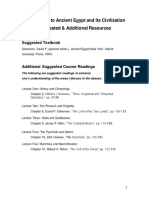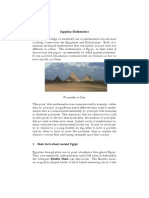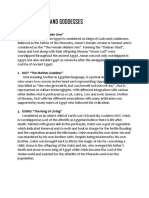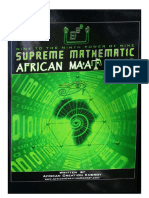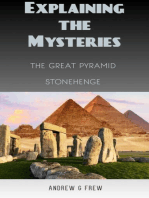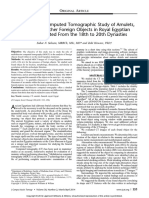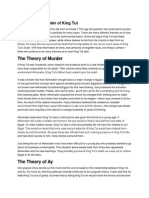Académique Documents
Professionnel Documents
Culture Documents
Dnatribes Digest
Transféré par
glowwormsCopyright
Formats disponibles
Partager ce document
Partager ou intégrer le document
Avez-vous trouvé ce document utile ?
Ce contenu est-il inapproprié ?
Signaler ce documentDroits d'auteur :
Formats disponibles
Dnatribes Digest
Transféré par
glowwormsDroits d'auteur :
Formats disponibles
DNA Tribes Digest January 1, 2012
All contents 2006-2012 DNA Tribes. DNA Tribes DNA Tribes patent pending analysis is available exclusively from DNA Tribes. All rights reserved.
DNA Tribes Digest January 1, 2012 Copyright 2012 DNA Tribes. All rights reserved.
To request an email subscription to DNA Tribes Digest, email digest@dnatribes.com with the subject heading Subscribe. To unsubscribe from DNA Tribes Digest, email digest@dnatribes.com with the subject heading Unsubscribe. Previous issues of DNA Tribes Digest are available online at http://dnatribes.com/library.html.
Table of Contents:
Introduction ..................................................................................................................................... 1 Last of the Amarna Pharaohs: King Tut and His Relatives ............................................................ 2 Historical Background ............................................................................................................ 2 Genetic Analysis of Amarna Mummies .................................................................................. 3 Conclusion .............................................................................................................................. 4 Appendix: Regional Analysis for Individual Amarna Mummies ........................................... 5 Getting the Most from Your STR Testing ...................................................................................... 9
Introduction
Hello, and welcome to the January 2012 issue of DNA Tribes Digest. This months article features an analysis of several mummies, including the famous King Tut and his relatives. These individuals lived in a unique time more than three thousand years ago: the Amarna period, which has left a vivid archaeological record of life in pharaonic Egypt. Best regards and Happy New Year, Lucas Martin DNA Tribes
DNA Tribes Digest January 1, 2012
Web: www.dnatribes.com; Email: dna@dnatribes.com Mail: DNA Tribes, P.O. Box 735, Arlington, VA 22216
Page 1 of 10
DNA Tribes Digest January 1, 2012
All contents 2006-2012 DNA Tribes. DNA Tribes DNA Tribes patent pending analysis is available exclusively from DNA Tribes. All rights reserved.
Last of the Amarna Pharaohs: King Tut and His Relatives
Historical Background
During the exploration of Egypt, a puzzle emerged along the Nile River: a singular ancient city that had been hastily abandoned to the desert. The site dated to the mid 1300s BCE (the height of New Kingdom Egypt) and became known as Amarna (named for the local Beni Amran tribe). Unusual discoveries here included cuneiform tablets (the Amarna letters), written in a peripheral Akkadian vernacular spoken in the Levantine cities of the former Hyksos and their relatives to the north. Even more unusual was the Amarna art found in the city. Unlike the idealized royal icons customary in ancient Egypt, Amarna was decorated with naturalistic portraits emphasizing the individuality of the kings family and retinue. Absent from Amarna were images of Egypts ancient pantheon. Instead, this abandoned city had been dedicated to the more abstract Aten, symbolized by the suns orb extending its rays.1 Examination of texts and monuments revealed this as the lost city of Akhetaten (Horizon of the Aten), freshly built for the rebel pharaoh Akhenaten and his wife Nefertiti. The iconoclastic Akhenaten had opposed the wealthy and influential priesthood of Egypt by closing temples, removing the names of the gods from monuments, and even forbidding use of the plural term gods. Known in life as Living in Maat (Justice or Truth), he was later remembered only as the Criminal of Akhetaten. After Akhenatens rule ended in unknown circumstances, his name was erased from all future king lists. Traditional polytheism was then re-established under Tutankhamun (King Tut) and the former vizier Ay.2 Despite helping the return to Egyptian customs, the names of Tut and Ay were also omitted from Egyptian records for their association with the rebel pharaoh. Shortly after it had been built, the city of Akhetaten was abandoned. Ironically, the ruins of the City of the Horizon became an archaeological time capsule. The Egyptian desert preserved the citys documents, naturalistic art, open air building designs, and urban layout as a testament to an innovative moment in ancient history. The end of the Amarna period marked the conclusion of the Thutmosid 18th Dynasty of Egypt. King Tut and his relatives were to be the last descendants of one of the ancient pharaonic families, sometimes said to have ancestral links with the Land of Punt (near the Horn of Africa).3 Archaeologists have discovered several royal mummies linked to the Amarna period. These include not only the famous mummy of King Tut, but also his mother KV35YL and relatives Amenhotep III and Yuya. However, the association of the mummy KV55 with the iconoclast of Amarna remains uncertain. KV55 has been tentatively identified as Akhenaten; however, it is still debated whether this is the rebel pharaoh himself or instead the remains of another relative (such as Smenkhkare).
During Akhenatens reign, the Aten was represented as a phonetic name and inscribed in a cartouche, suggesting an abstract yet personal concept of deity sometimes compared to the Abrahamic traditions. For instance, some scholars have compared Psalm 104 with devotional poetry found in the ruins of Akhetaten. 2 Ay was Overseer of All the Horses of His Majesty and possibly the father-in-law of Akhenaten and related to several studied Amarna mummies. 3 More recently, some archaeologists have compared the Predynastic Naqada culture of Egypt with the A-Group culture of Nubia (located south of Egypt along the Nile River).
DNA Tribes Digest January 1, 2012
Web: www.dnatribes.com; Email: dna@dnatribes.com Mail: DNA Tribes, P.O. Box 735, Arlington, VA 22216
Page 2 of 10
DNA Tribes Digest January 1, 2012
All contents 2006-2012 DNA Tribes. DNA Tribes DNA Tribes patent pending analysis is available exclusively from DNA Tribes. All rights reserved.
Genetic Analysis of Amarna Mummies
Geographical analysis of the Amarna mummies was performed using their autosomal STR profiles based on 8 tested loci.4 Results are summarized in Table 1 and illustrated in Figure 1. Maps for individual Amarna mummies are included in Figures 2-8 in the Appendix. Discussion: Average MLI scores in Table 1 indicate the STR profiles of the Amarna mummies would be most frequent in present day populations of several African regions: including the Southern African (average MLI 326.94), African Great Lakes (average MLI 323.76), and Tropical West African (average MLI 83.74) regions. These regional matches do not necessarily indicate an exclusively African ancestry for the Amarna pharaonic family. However, results indicate these ancient individuals inherited some alleles that today are more frequent in populations of Africa than in other parts of the world (such as D18S51=19 and D21S11=34).
MLIforWorldRegion SouthernAfrican AfricanGreatLakes TropicalWestAfrican HornofAfrica Sahelian Levantine Aegean Arabian NorthwestEuropean Mediterranean NorthAfrican Mesopotamian
Thuya 359.72 233.49 142.84 14.65 39.14 0.40 0.12 0.12 0.21 0.08 2.22 0.06
Yuya 34.48 35.53 8.91 0.79 0.74 1.56 0.35 0.42 0.28 0.23 0.21 0.41
KV35EL 20.73 20.87 6.93 5.17 5.76 0.66 0.87 0.70 1.26 0.74 0.75 0.63
Amen hotepIII 108.53 222.53 37.43 12.03 2.97 10.30 9.06 5.58 3.99 4.54 3.39 6.24
KV55 174.90 381.30 53.03 4.54 4.40 6.07 7.05 2.83 10.41 5.81 3.25 2.69
KV35YL 71.17 44.58 22.99 22.00 16.85 8.40 20.16 21.41 15.01 16.80 12.63 11.54
Tut 1,519.03 1,328.01 314.00 44.35 30.41 21.08 9.85 10.91 5.33 6.04 6.55 5.27
Average 326.94 323.76 83.74 14.79 14.33 6.92 6.78 6.00 5.21 4.89 4.14 3.84
Table 1: Top MLI (Match Likelihood Index) scores for Amarna mummies based on the world regions identified by DNA Tribes STR analysis. Each MLI score identifies the likelihood of occurrence of an STR profile in that region versus the likelihood of occurrence in the world as a whole.
For original data, see http://jama.ama-assn.org/content/303/7/638.full.
DNA Tribes Digest January 1, 2012
Web: www.dnatribes.com; Email: dna@dnatribes.com Mail: DNA Tribes, P.O. Box 735, Arlington, VA 22216
Page 3 of 10
DNA Tribes Digest January 1, 2012
All contents 2006-2012 DNA Tribes. DNA Tribes DNA Tribes patent pending analysis is available exclusively from DNA Tribes. All rights reserved.
Figure 1: Map of average regional match likelihood (MLI) scores for the Amarna mummies. For more information about the world regions identified in DNA Tribes STR based tests, see http://dnatribes.com/populations.html.
Conclusion
Results indicated the autosomal STR profiles of the Amarna period mummies were most frequent in modern populations in several parts of Africa. These results are based on the 8 STR markers for which these pharaonic mummies have been tested, which allow a preliminary geographical analysis for these individuals who lived in Egypt during the Amarna period of the 14th century BCE. Although results do not necessarily suggest exclusively African ancestry, geographical analysis suggests ancestral links with neighboring populations in Africa for the studied pharaonic mummies. If new data become available in the future, it might become possible to further clarify results and shed new light on the relationships of ancient individuals to modern populations.
DNA Tribes Digest January 1, 2012
Web: www.dnatribes.com; Email: dna@dnatribes.com Mail: DNA Tribes, P.O. Box 735, Arlington, VA 22216
Page 4 of 10
DNA Tribes Digest January 1, 2012
All contents 2006-2012 DNA Tribes. DNA Tribes DNA Tribes patent pending analysis is available exclusively from DNA Tribes. All rights reserved.
Appendix: Regional Analysis for Individual Amarna Mummies
Figure 2: Thuya.
Figure 3: Yuya.
DNA Tribes Digest January 1, 2012
Web: www.dnatribes.com; Email: dna@dnatribes.com Mail: DNA Tribes, P.O. Box 735, Arlington, VA 22216
Page 5 of 10
DNA Tribes Digest January 1, 2012
All contents 2006-2012 DNA Tribes. DNA Tribes DNA Tribes patent pending analysis is available exclusively from DNA Tribes. All rights reserved.
Figure 4: KV35EL (the Elder Lady, possibly Tiye).
Figure 5: Amenhotep III.
DNA Tribes Digest January 1, 2012
Web: www.dnatribes.com; Email: dna@dnatribes.com Mail: DNA Tribes, P.O. Box 735, Arlington, VA 22216
Page 6 of 10
DNA Tribes Digest January 1, 2012
All contents 2006-2012 DNA Tribes. DNA Tribes DNA Tribes patent pending analysis is available exclusively from DNA Tribes. All rights reserved.
Figure 6: KV55 (possibly Akhenaten or Smenkhkare).
Figure 7: KV35YL (the Younger Lady).
DNA Tribes Digest January 1, 2012
Web: www.dnatribes.com; Email: dna@dnatribes.com Mail: DNA Tribes, P.O. Box 735, Arlington, VA 22216
Page 7 of 10
DNA Tribes Digest January 1, 2012
All contents 2006-2012 DNA Tribes. DNA Tribes DNA Tribes patent pending analysis is available exclusively from DNA Tribes. All rights reserved.
Figure 8: Tutankhamun.
DNA Tribes Digest January 1, 2012
Web: www.dnatribes.com; Email: dna@dnatribes.com Mail: DNA Tribes, P.O. Box 735, Arlington, VA 22216
Page 8 of 10
DNA Tribes Digest January 1, 2012
All contents 2006-2012 DNA Tribes. DNA Tribes DNA Tribes patent pending analysis is available exclusively from DNA Tribes. All rights reserved.
Getting the Most from Your STR Testing
Once your 15, 21 or 27 Marker Kit STR testing is complete, we offer several options to keep your report current and customize your genetic analysis for the information you want. (Prices are listed as of January 1, 2012 and are subject to change.) Updating Your Analysis: DNA Tribes analysis is updated on a periodic basis to include new reference data as well as refinements to our match algorithms and world regions analysis. (A map illustrating current populations and genetic regions is available at http://dnatribes.com/populations.html.) After your testing is complete, your analysis can be updated at any times of your choice for $24.99 through our secure online checkout at http://dnatribes.com/order_addons.html. Customizing Your Analysis with Add-On Reports: DNA Tribes offers several $24.99 Add-On reports to customize your analysis: African Panel: A listing of your DNA match scores for all individual Sub-Saharan African populations in our database. Central Asian Panel: A listing of your DNA match scores for individual native Central Asian and Siberian populations in our database, also including Roma (European Gypsy) match scores. East Asian Panel: A listing of your DNA match scores for East Asian populations in our database, including all individual Chinese, Japanese, Korean, and Southeast Asian populations. Middle Eastern Panel: A listing of your DNA match scores for Middle Eastern populations in our database, including all individual Arab, Berber, Caucasus, Jewish, Persian, and Turkish populations. Native American Panel: A listing of your DNA match scores for all individual Native American populations in our database. South Asian Panel: A listing of your DNA match scores for South Asian populations in our database, including all individual populations of Bangladesh, India, Nepal, Pakistan, and Sri Lanka. Extended Match Results: A comprehensive listing of your DNA match scores for all individual populations in our database. Once lab testing is complete, Add-On reports can be performed at any time (without the need to submit new DNA samples) by ordering through our secure online checkout at http://dnatribes.com/order_addons.html.
DNA Tribes Digest January 1, 2012
Web: www.dnatribes.com; Email: dna@dnatribes.com Mail: DNA Tribes, P.O. Box 735, Arlington, VA 22216
Page 9 of 10
DNA Tribes Digest January 1, 2012
All contents 2006-2012 DNA Tribes. DNA Tribes DNA Tribes patent pending analysis is available exclusively from DNA Tribes. All rights reserved.
DNA Tribes Europa: A Detailed Comparison to European Sub-Regions: DNA Tribes Europa provides the most detailed and complete analysis of European autosomal genetic structure available. DNA Tribes Europa provides your DNA match scores for 17 genetic subregions of Europe, which is substantially more robust than the individual population matches in Parts B C of reports and more detailed than the European world regions referenced in Part D of core results. More information about DNA Tribes http://dnatribes.com/dnatribes-europa.html Confirm or Clarify Your Results with Lab Upgrade: For customers who have completed testing with DNA Tribes, we offer 15-to-21, 15-to-27 and 21-to-27 Marker Upgrade tests. Upgrades include lab testing of additional STR marker systems, allowing a closer comparison of your own DNA to world populations for enhanced match precision and power of exclusion. The incorporation of additional marker systems can confirm or clarify your existing results, and all upgrades includes an update to all Add-On reports previously ordered for your kit. Upgrades are available through our secure online checkout system at: http://dnatribes.com/order_upgrades.html. Researching Your Results: Each persons DNA Tribes results are one of a kind and express their own unique collection of genetic material inherited from both paternal and maternal ancestors. Your personal DNA matches can express recent family genealogy and more ancient genetic relationships among world populations. A library of articles based on DNA Tribes original ongoing research and analysis of world genetic structure is available free at http://dnatribes.com/library.html. Europa is available for $49.99 at:
DNA Tribes Digest January 1, 2012
Web: www.dnatribes.com; Email: dna@dnatribes.com Mail: DNA Tribes, P.O. Box 735, Arlington, VA 22216
Page 10 of 10
Vous aimerez peut-être aussi
- Ancient Egypt Introduction and ResourcesDocument7 pagesAncient Egypt Introduction and ResourcesNathanPas encore d'évaluation
- Caribbean SymbolismDocument10 pagesCaribbean Symbolismapi-269918374100% (1)
- Het Heru DanceDocument2 pagesHet Heru DanceAankh BenuPas encore d'évaluation
- Hymn To Aten and Ciluba2Document17 pagesHymn To Aten and Ciluba2Simon Van RillaerPas encore d'évaluation
- Uraeus: From Wikipedia, The Free EncyclopediaDocument6 pagesUraeus: From Wikipedia, The Free Encyclopediaelgorrion98Pas encore d'évaluation
- 1st Class Intro Conversational TwiDocument10 pages1st Class Intro Conversational TwiAbibitumiKasaPas encore d'évaluation
- African Origins and IdentityDocument9 pagesAfrican Origins and IdentitySabelo MnukwaPas encore d'évaluation
- The Connection of Akhenetan and The KourosDocument6 pagesThe Connection of Akhenetan and The KourosLewis Von PoobisPas encore d'évaluation
- Reading Explorer2 Unit 3 Extra Questions StudentsDocument5 pagesReading Explorer2 Unit 3 Extra Questions StudentsAlexPas encore d'évaluation
- PamPhlet 5 of KemPtah MathDocument20 pagesPamPhlet 5 of KemPtah MathKumwaga Ra-Nu Kiganga KemPtah100% (2)
- A Tour of Atlantis: or What Happens in The Astral RealmDocument56 pagesA Tour of Atlantis: or What Happens in The Astral RealmWayne O'BoogiePas encore d'évaluation
- The Story of RaDocument6 pagesThe Story of RaRamon T JuarezPas encore d'évaluation
- Kingship and Religion - Prof. Mathole MotshekgaDocument6 pagesKingship and Religion - Prof. Mathole Motshekgaillumin7Pas encore d'évaluation
- Egypt MathDocument21 pagesEgypt MathYoungil KimPas encore d'évaluation
- Atomic Theory Explained: Elements, Compounds and the Discovery of Subatomic ParticlesDocument8 pagesAtomic Theory Explained: Elements, Compounds and the Discovery of Subatomic ParticlesBill BiazonPas encore d'évaluation
- Note About Luminiferous Aether - TranscriptDocument6 pagesNote About Luminiferous Aether - TranscriptdaicemanPas encore d'évaluation
- A New Cosmological Model For Matter, Energy, Sound, The Origin of The Universe and GravityDocument17 pagesA New Cosmological Model For Matter, Energy, Sound, The Origin of The Universe and GravitySuyogPas encore d'évaluation
- The Gods of The Egyptians Vol1 - Chapter VIII - The History of The Creation of The Gods and of The World - Version ADocument4 pagesThe Gods of The Egyptians Vol1 - Chapter VIII - The History of The Creation of The Gods and of The World - Version AOrockjoPas encore d'évaluation
- Egyptian Love PoetryDocument15 pagesEgyptian Love PoetrylouishaiPas encore d'évaluation
- Maat & IsftDocument4 pagesMaat & IsftNosoPas encore d'évaluation
- The RBG Maafa European Holocaust of Afrikan Enslavement and Reparations CollectionDocument13 pagesThe RBG Maafa European Holocaust of Afrikan Enslavement and Reparations CollectionTheMothership100% (1)
- Class Ppts Fact Files GodsDocument15 pagesClass Ppts Fact Files Godsapi-236706693Pas encore d'évaluation
- Egypt Kemet - The Melanin Origins of The Spirit - Project I - Am - YouDocument2 pagesEgypt Kemet - The Melanin Origins of The Spirit - Project I - Am - YoumjsfwfesPas encore d'évaluation
- Egyptian God of Emerging Land After Floodwaters RecedeDocument5 pagesEgyptian God of Emerging Land After Floodwaters RecedeKoop Da VillePas encore d'évaluation
- Agni Purana A Study (English) by Dr.S.D. Gyani, Chowkhamba Sanskrit Series 42, 1964, Varanasi - Chowkhamba Sanskrit Series Office, VaranasiDocument406 pagesAgni Purana A Study (English) by Dr.S.D. Gyani, Chowkhamba Sanskrit Series 42, 1964, Varanasi - Chowkhamba Sanskrit Series Office, VaranasiBranko NikolicPas encore d'évaluation
- Ancient Egytian ScriptsDocument3 pagesAncient Egytian ScriptsCreators CollegePas encore d'évaluation
- The Instruction of PtahhotepDocument13 pagesThe Instruction of PtahhotepTristan PanPas encore d'évaluation
- Afrocentricity and Africology. Brooklyn, NY: Universal WriteDocument4 pagesAfrocentricity and Africology. Brooklyn, NY: Universal WritejakilaPas encore d'évaluation
- The Calendars of Ancient Egypt: BCE BCEDocument22 pagesThe Calendars of Ancient Egypt: BCE BCERobert DavisPas encore d'évaluation
- SUMERIANDocument147 pagesSUMERIANTomek 'entombet' GiełaPas encore d'évaluation
- Ammit (Kemetic Afterlife Mythology)Document2 pagesAmmit (Kemetic Afterlife Mythology)Alison_VicarPas encore d'évaluation
- The Dogon and Math PDFDocument5 pagesThe Dogon and Math PDFsuerock100% (1)
- Ancient Kemetic gods and goddessesDocument3 pagesAncient Kemetic gods and goddessesAzakah IbrahimPas encore d'évaluation
- Unit Lesson Inner PlanetsDocument25 pagesUnit Lesson Inner PlanetskarleyroyalPas encore d'évaluation
- A Amnual of Egyptian PotteryDocument309 pagesA Amnual of Egyptian PotteryTomislavMenalo100% (1)
- Ancient Mayan Reckoning Names Compared To Ancient EgyptianDocument0 pageAncient Mayan Reckoning Names Compared To Ancient EgyptianDavid Jose Lopez WongPas encore d'évaluation
- CIA Final Response Letter RE Hunter ThompsonDocument1 pageCIA Final Response Letter RE Hunter ThompsonRobPas encore d'évaluation
- PtahDocument11 pagesPtahAnonymous WpMUZCb935Pas encore d'évaluation
- MumificationDocument717 pagesMumificationrafiya rahmanPas encore d'évaluation
- Instuctions of Ptah HoptepDocument10 pagesInstuctions of Ptah HoptepWalid Hesham GhareebPas encore d'évaluation
- COPPENS, HB SSP Mnx.t. A Feast of Re-Harsomtus of Khadi On MesoreDocument13 pagesCOPPENS, HB SSP Mnx.t. A Feast of Re-Harsomtus of Khadi On MesoreHesham ElshazlyPas encore d'évaluation
- Prophecy of NefertyDocument21 pagesProphecy of NefertyDr. Ọbádélé KambonPas encore d'évaluation
- Polymorphic or Pantheistic Deities PDFDocument16 pagesPolymorphic or Pantheistic Deities PDFsoha elmahdyPas encore d'évaluation
- Egyptian Writing Systems and GrammarDocument10 pagesEgyptian Writing Systems and Grammarillumin7100% (1)
- Bantu LanguagesDocument30 pagesBantu LanguagesTabitha SandersPas encore d'évaluation
- The Nile Valley Egypt's Old Kingdom The Egyptian Empire The Civilization of KushDocument20 pagesThe Nile Valley Egypt's Old Kingdom The Egyptian Empire The Civilization of KushmsgasconPas encore d'évaluation
- Black African, Dravidian, Elamite and Sumerian LanguagesDocument17 pagesBlack African, Dravidian, Elamite and Sumerian LanguagesAsarPas encore d'évaluation
- Root Race: Language Watch EditDocument8 pagesRoot Race: Language Watch EditRachel RykesPas encore d'évaluation
- The Conquest of Al-Andalus (711 - 732)Document7 pagesThe Conquest of Al-Andalus (711 - 732)mansourvcxPas encore d'évaluation
- Ancient - Egypt 2 GoddessDocument15 pagesAncient - Egypt 2 GoddessJacquilyn HernandezPas encore d'évaluation
- Greek Gods and GoddessessDocument22 pagesGreek Gods and GoddessessOwii De LeonPas encore d'évaluation
- Celestial Sphere Star ChartsDocument3 pagesCelestial Sphere Star ChartsLonn ConleyPas encore d'évaluation
- The Number of Tectonic Hazards Is Not IncreasingDocument5 pagesThe Number of Tectonic Hazards Is Not IncreasingJhenna LlanesPas encore d'évaluation
- Ancient Egypt ProjectDocument58 pagesAncient Egypt ProjectCharan MohtaPas encore d'évaluation
- Egyptian Gods and GoddessesDocument9 pagesEgyptian Gods and GoddessesAngemar Roquero MirasolPas encore d'évaluation
- Screenshot 2023-12-31 at 17.48.09Document145 pagesScreenshot 2023-12-31 at 17.48.09Ejiofor William ChinonsoPas encore d'évaluation
- Hieroglyphic Vocabulary With An Index To All The English Equivalents of The Egyptian WordsDocument538 pagesHieroglyphic Vocabulary With An Index To All The English Equivalents of The Egyptian WordsAtraPas encore d'évaluation
- Shabaka StoneDocument36 pagesShabaka StoneGbemiro Ogunfowote100% (1)
- Apple S Unkept PromisesDocument62 pagesApple S Unkept PromisesglowwormsPas encore d'évaluation
- Bird Studies CanadaDocument1 pageBird Studies CanadaglowwormsPas encore d'évaluation
- Survival ChecklistDocument2 pagesSurvival ChecklistglowwormsPas encore d'évaluation
- A CRITICAL ANALYSIS OF DROPBOX SOFTWARE SECURITYDocument31 pagesA CRITICAL ANALYSIS OF DROPBOX SOFTWARE SECURITYglowwormsPas encore d'évaluation
- The Psychology of Sunk CostDocument17 pagesThe Psychology of Sunk CostglowwormsPas encore d'évaluation
- The Psychology of Sunk CostDocument17 pagesThe Psychology of Sunk CostglowwormsPas encore d'évaluation
- Survey of Chemical and Biological WarfareDocument23 pagesSurvey of Chemical and Biological Warfareglowworms0% (1)
- INDIA AND THE WORLD. History TimelineDocument62 pagesINDIA AND THE WORLD. History Timelineworld civilization100% (2)
- Was King Tut Murdered?Document4 pagesWas King Tut Murdered?mauricio760Pas encore d'évaluation
- 11 EnglishDocument12 pages11 EnglishIndrajitPas encore d'évaluation
- Akhenaton PDFDocument16 pagesAkhenaton PDFArtur FelisbertoPas encore d'évaluation
- NCERT Solutions for Class 11 English Hornbill Chapter 3 Discovering Tut: The Saga ContinuesDocument3 pagesNCERT Solutions for Class 11 English Hornbill Chapter 3 Discovering Tut: The Saga ContinuesNS suPER ZoNEPas encore d'évaluation
- NotesDocument84 pagesNotesneemthas761Pas encore d'évaluation
- Discovering Tut The Saga ContinuesDocument4 pagesDiscovering Tut The Saga ContinuesJenny Yadv100% (11)
- Origami: Which of The Following Questions Are Answered in This Passage?Document2 pagesOrigami: Which of The Following Questions Are Answered in This Passage?fernandaPas encore d'évaluation
- TaSeti2000 PDFDocument1 819 pagesTaSeti2000 PDFdhdavd6134Pas encore d'évaluation
- Study Guide: The Mystery of King TutDocument8 pagesStudy Guide: The Mystery of King TutmontalvoartsPas encore d'évaluation
- ITF 2006 SummerDocument22 pagesITF 2006 SummerPedro LunaPas encore d'évaluation
- Reading 5Document79 pagesReading 5dangnganha159100% (2)
- Early Art & CivilizationsDocument12 pagesEarly Art & Civilizationsmel0nPas encore d'évaluation
- Olivia A To Z Project 1Document17 pagesOlivia A To Z Project 1Lee Ward SartoriPas encore d'évaluation
- COMPARING Lost Treasures of Egypt' AND Discovering TUT - The Saga Continues Holiday Homework by ShivanshiDocument12 pagesCOMPARING Lost Treasures of Egypt' AND Discovering TUT - The Saga Continues Holiday Homework by ShivanshiShivanshi BansalPas encore d'évaluation
- TutankhamunDocument14 pagesTutankhamunJoan AdvinculaPas encore d'évaluation
- Eng PresentationDocument9 pagesEng PresentationNasiha FathimaPas encore d'évaluation
- Multidetector Computed Tomographic Study of AmuletsDocument6 pagesMultidetector Computed Tomographic Study of Amuletssychev_dmitryPas encore d'évaluation
- Class 11 English Project 'The Valley of Kings'Document22 pagesClass 11 English Project 'The Valley of Kings'Arjun RatanPas encore d'évaluation
- Egypt's 18th DynastyDocument21 pagesEgypt's 18th DynastyKanav SinghalPas encore d'évaluation
- The Detective As Historian History and Art in Historical Crime Fiction (Ray B. Browne, Lawrence A. Kreiser Etc.) (Z-Library)Document321 pagesThe Detective As Historian History and Art in Historical Crime Fiction (Ray B. Browne, Lawrence A. Kreiser Etc.) (Z-Library)alexamaral1989Pas encore d'évaluation
- Ancient EgyptDocument58 pagesAncient EgyptRicardo Esquivel SilvaPas encore d'évaluation
- Discovering Tut The Saga ContinuesDocument6 pagesDiscovering Tut The Saga ContinuesAryan KumarPas encore d'évaluation
- Discovering TutDocument8 pagesDiscovering TutHeeral RangaPas encore d'évaluation
- Akhenaton MosesDocument18 pagesAkhenaton MosesKyle Fernando Foster-ElPas encore d'évaluation
- Aknaton and Christianity - Charles PopeDocument14 pagesAknaton and Christianity - Charles PopeRV Payne100% (2)
- ancient egypt 参考书目 PDFDocument56 pagesancient egypt 参考书目 PDFnemesis123Pas encore d'évaluation
- The Death or Murder of King TutDocument4 pagesThe Death or Murder of King Tutapi-235980768Pas encore d'évaluation
